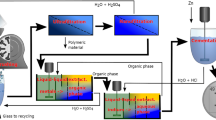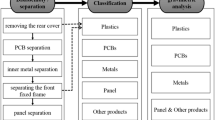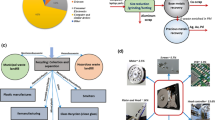Abstract
Currently, more than 55% of global indium production is consumed for indium tin oxide (ITO) production because of its excellent display properties mainly driven by demand for flat panel displays (FPDs) or LCDs. At the end of life, the waste LCD flows to the e-waste stream, accounts for 12.5% of the global e-waste, and is forecasted to be increasing progressively. These waste LCDs are potential wealth for indium that poses a threat to the environment. The volume of waste LCD generation is a global as well as national concern from a waste management perspective. Techno-economical recycling of this waste can be a panacea to the challenges associated with the lack of commercial technology and extensive research. Hence, a mass production capable of beneficiation and classification of ITO concentrate from waste LCD panels has been investigated. The mechanical beneficiation process for waste LCDs consists of five steps of operation, i.e., (i) size reduction by shredding by jaw milling, (ii) further size reduction to feed for ball milling, (iii) ball milling, (iv) classification to enrich ITO concentrate, and (v) characterization ITO concentrate and confirmation. The bench-scale process developed is intended to integrate with our indigenously developed dismantling plant (which can handle 5000 tons per annum) to handle separated waste LCD glass for indium recovery. Once scaled up, it can be integrated for continuous operation synchronized with the LCD dismantling plant.








Similar content being viewed by others
Data Availability
All data generated or analysed during this study are included in this published article (and its supplementary information files).
References
Akcil A, Agcasulu I, Swain B (2019) Valorization of waste LCD and recovery of critical raw material for circular economy: a review. Resour Conserv Recycl 149:622–637
Alfantazi AM, Moskalyk RR (2003) Processing of indium: a review. Miner Eng 16:687–694
Dongchul Choi YSK, Yongkeun Son (2022) Recovery of indium tin oxide (ITO) and glass plate from discarded TFTLCD panel using an electrochemical method and acid treatments. RSC Advances Inpress
Ferella F, Belardi G, Marsilii A, De Michelis I, Veglio F (2017) Separation and recovery of glass, plastic and indium from spent LCD panels. Waste Manag 60:569–581
Forti V, Balde CP, Kuehr R, Bel G (2020) The Global E-waste Monitor 2020: quantities, flows and the circular economy potential, Bonn/Geneva/Rotterdam
https://www.marketwatch.com/ (2022): Indium tin oxide (ITO) market size in 2022. https://www.marketwatch.com/
Illés IB, Nagy S, Kékesi T (2022) The recycling of pure metallic indium from waste LCD screens by a combined hydro-electrometallurgical method. Hydrometallurgy 213:105945
Lahtela V, Virolainen S, Uwaoma A, Kallioinen M, Kärki T, Sainio T (2019) Novel mechanical pre-treatment methods for effective indium recovery from end-of-life liquid-crystal display panels. J Clean Prod 230:580–591
Laricchia F (2022) LCD TV shipments worldwide by vendor 2015–2019. Statista Inc., https://www.statista.com/
Lee C-H, Jeong M-K, Fatih Kilicaslan M, Lee J-H, Hong H-S, Hong S-J (2013) Recovery of indium from used LCD panel by a time efficient and environmentally sound method assisted HEBM. Waste Manage 33:730–734
Li J, Gao S, Duan H, Liu L (2009) Recovery of valuable materials from waste liquid crystal display panel. Waste Manage 29:2033–2039
Mei F, Li R, Yuan T (2020) Transparent and conductive applications of tin oxide. 579–597
Moroney LODP (2017) Investigation of liquid crystal displays as a source of indium. Environmental Protection Agency, Wexford, Ireland
Nakajima K, Yokoyama K, Nakano K, Nagasaka T (2008) Substance flow analysis of indium for flat panel displays in Japan. J Jpn Inst Met 72:99–104
Rocchetti L, Amato A, Fonti V, Ubaldini S, De Michelis I, Kopacek B, Vegliò F, Beolchini F (2015) Cross-current leaching of indium from end-of-life LCD panels. Waste Manage 42:180–187
Schuster J, Ebin B (2021) Investigation of indium and other valuable metals leaching from unground waste LCD screens by organic and inorganic acid leaching. Sep Purif Technol 279:119659
Swain B, Mishra C, Hong HS, Cho S-S (2015a) Treatment of indium-tin-oxide etching wastewater and recovery of In, Mo, Sn and Cu by liquid–liquid extraction and wet chemical reduction: a laboratory scale sustainable commercial green process. Green Chem 17:4418–4431
Swain B, Mishra C, Hong HS, Cho S-S, Sk L (2015b) Commercial process for the recovery of metals from ITO etching industry wastewater by liquid–liquid extraction: simulation, analysis of mechanism, and mathematical model to predict optimum operational conditions. Green Chem 17:3979–3991
Swain B, Mishra C, Hong HS, Cho S-S (2016) Beneficiation and recovery of indium from liquid-crystal-display glass by hydrometallurgy. Waste Manage 57:207–214
Swain B, Lee C, Hong H (2018) Value recovery from waste liquid crystal display glass cullet through leaching: understanding the correlation between indium leaching behavior and cullet piece size. Metals 8:235
Werner TT, Mudd GM, Jowitt SM (2015) Indium: key issues in assessing mineral resources and long-term supply from recycling. Appl Earth Sci 124:213–226
Zhang K, Wu Y, Wang W, Li B, Zhang Y, Zuo T (2015) Recycling indium from waste LCDs: a review. Resour Conserv Recycl 104:276–290
Zhang K, Li B, Wu Y, Wang W, Li R, Zhang Y-N, Zuo T (2017a) Recycling of indium from waste LCD: a promising non-crushing leaching with the aid of ultrasonic wave. Waste Manage 64:236–243
Zhang K, Li B, Wu Y, Wang W, Li R, Zhang YN, Zuo T (2017b) Recycling of indium from waste LCD: a promising non-crushing leaching with the aid of ultrasonic wave. Waste Manag 64:236–243
Zhang L, Wu B, Chen Y, Xu Z (2017c) Treatment of liquid crystals and recycling indium for stripping product gained by mechanical stripping process from waste liquid crystal display panels. J Clean Prod 162:1472–1481
Funding
This work was supported by the Korea Environment Industry & Technology Institute (KEITI) funded by the Korea Ministry of Environment (MOE) (2022003500003). Primary author Jae Ryang Park has received research support from Institute for Advanced Engineering (IAE), Korea for his PhD thesis.
Author information
Authors and Affiliations
Contributions
Jae Ryang Park is the primary contributor as part of his doctoral thesis, and he has contributed to all experiments, analyses, and data organization. Chan Gi Lee has received funding and conceiving the project idea. Basudev Swain contributed to data advising, analysis, data curation, and manuscript preparation.
Corresponding author
Ethics declarations
Ethical approval
The manuscript has neither been previously published elsewhere nor is currently being considered for publication elsewhere. The paper reflects the authors’ own research and analysis in a truthful and complete manner. The paper properly credits the meaningful contributions of co-authors and co-researchers. The results are appropriately placed in the context of prior and existing research.
Consent to participate
All authors have been personally and actively involved in substantial work leading to the paper and will take public responsibility for its content.
Consent for publication
All authors have personally and actively consented to the publication of the current manuscript.
Competing interests
The authors declare no competing interests.
Additional information
Responsible Editor: George Z. Kyzas
Publisher's Note
Springer Nature remains neutral with regard to jurisdictional claims in published maps and institutional affiliations.
Jae Ryang Park is the primary contributor as part of his doctoral thesis.
Supplementary Information
Below is the link to the electronic supplementary material.
Rights and permissions
Springer Nature or its licensor (e.g. a society or other partner) holds exclusive rights to this article under a publishing agreement with the author(s) or other rightsholder(s); author self-archiving of the accepted manuscript version of this article is solely governed by the terms of such publishing agreement and applicable law.
About this article
Cite this article
Park, J.R., Lee, C.G. & Swain, B. Beneficiation and classification of ITO concentrate from waste LCD panel for industrial-scale indium extraction. Environ Sci Pollut Res 30, 90209–90222 (2023). https://doi.org/10.1007/s11356-023-26106-1
Received:
Accepted:
Published:
Issue Date:
DOI: https://doi.org/10.1007/s11356-023-26106-1




